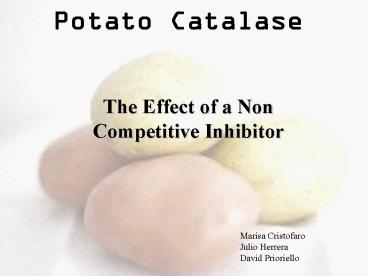Potato Catalase - PowerPoint PPT Presentation
1 / 11
Title:
Potato Catalase
Description:
A small piece of filter paper was dipped into the potato solution for 3 seconds. ... timer was started as soon as the piece of filter paper hit the solution, since ... – PowerPoint PPT presentation
Number of Views:190
Avg rating:3.0/5.0
Title: Potato Catalase
1
Potato Catalase
The Effect of a Non Competitive Inhibitor
Marisa Cristofaro Julio Herrera David Prioriello
2
THEORY
Inhibitor ? A molecule that interacts with an
enzyme and decreases its activity.
? Non-competitive inhibition of an enzyme can
occur when an inhibitor binds somewhere other
than the active site of an enzyme. This causes
the enzyme molecule to change shape so that the
substrate molecule can no longer bind to the
active site.
Result the non-competitive inhibitor slows down
the reaction rate, thus increasing the reaction
time.
Copper sulfate ? Non-competitive inhibitor of
catalase.
3
Background
Objective -Study the activity of potato
catalase under various concentrations of H2O2 and
under the influence of an inhibitor.
? This experiment was mainly conducted to study
the effect of Copper Sulfate (CuSO4) on the
reaction rate of peroxide turning into oxygen and
water as shown below
Catalase Enzyme
2 H2O2 ? O2 H2O
4
Hypothesis
- As the amount of H2O2 substrate is increased, a
substantial increase in reaction rate (decrease
in reaction time) should occur.
Reasoning Since the amount of inhibitor
remains constant throughout the experiment,
increasing the peroxide (substrate) concentration
should allow for much more substrate binding to
the active site compared to inhibitor binding
greatly increasing the reaction rate.
5
Overview of Procedure
? A 1cm cube of the inside of a potato was
crushed and mixed with 5ml distilled water,
? A 3 hydrogen peroxide solution was used to
observe catalase activity. From it, solutions of
2 and 1 hydrogen peroxide were prepared.
? 0.1g of copper sulfate inhibitor was added to
the solution of hydrogen peroxide, which was then
stirred
? A small piece of filter paper was dipped into
the potato solution for 3 seconds. The paper was
then transferred to the solution of hydrogen
peroxide mixed with the inhibitor.
6
? The timer was started as soon as the piece of
filter paper hit the solution, since this is
where catalase activity begins.
? The end point (when the timer was stopped) was
taken when the paper rose from the bottom. This
was preferred over an endpoint at the top of the
solution, since
- We want to minimize random and systematic error
due to the physics of the setup, e.g. forces that
would prevent it from rising freely. - Also, we dont want to base ourselves on the
height of the solution, which is rather arbitrary
and dependant on the size of the test tubes, but
rather on something that will remain constant,
such as the point where the forces of oxygen gas
wanting to rise just surpass the weight of the
paper disc.
7
The process of timing the rise of a paper disc on
a solution of Hydrogen Peroxide and copper
sulfate was repeated 5 times for each
concentration of Hydrogen Peroxide investigated
(3, 2, and 1)
8
Results
A graph of the average reaction times for each
concentration of hydrogen peroxide
As expected, the reaction is MUCH faster under
higher concentrations there is less inhibitor
present per quantity of H2O2 substrate, therefore
more H2O2 substrate binding to the active site
compared to inhibitor binding.
9
(No Transcript)
10
Conclusion
11
References































